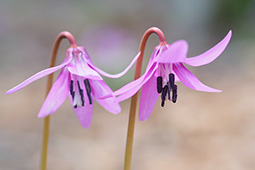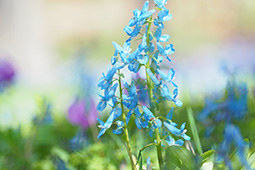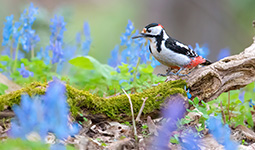April 2022
- English
- 日本語
A Fairy Tale Flower Garden

An ezorisu (Hokkaido squirrel) among the katakuri (Japanese dogtooth violets) and ezoengosaku (corydalis) at Urausu Shrine 
Japanese dogtooth violets and ezoengosaku corydalis flowering on the grounds of Urausu Shrine in Urausu Town, Hokkaido.

Japanese dogtooth violets 
Ezoengosaku corydalis grow predominantly in Hokkaido 
An akagera (great spotted woodpecker) amidst the ezoengosaku corydalis

Japanese dogtooth violets and corydalis bloom in late April in Hokkaido, Japan’s northernmost region, where they signal the arrival of spring. These flowers grow abundantly in Hokkaido’s Urausu Town, attracting wild birds and animals, who appear among the flowers and create a fairy tale world.

The lovely light purple blossoms of katakuri (Japanese dogtooth violets), a plant in the lily family, bloom profusely within the grounds of Urausu Shrine in Urausu Town each year from late April through May. The pretty blue flowers of ezoengosaku (Corydalis ambigua), a small corydalis in the poppy family, bloom alongside the dogtooth violets, creating a garden with fairy tale-like colors across the expansive shrine grounds.
Urausu Town (population approximately 1,700 as of February 2022) is located in central western Hokkaido and is known for having a winery with the largest wine grape acreage in Japan. An official at the Urausu Town local government says of the spring flowers, “Urausu Town is an area with a lot of snow, even for Hokkaido. The flowers that we see as the snow begins to melt herald the return of spring, and everyone in the area looks forward to it.”

Japanese dogtooth violets can be seen widely from northeastern Asia to most parts of Japan, but the ezoengosaku corydalis grow predominantly in Hokkaido. Both are perennial plants, where buds appear on the ground’s surface and flowers bloom, but after the leaves have withered, the plant waits for the next spring underground as a stem. Plants that only make an appearance above ground for an extremely short period of time in the spring are known as “spring ephemerals,” or “spring fairies” in Japanese.
Springtime at Urausu Shrine, surrounded by light purple and blue flowers and fresh green from the various sprouting grasses, becomes a lively sight, a complete contrast to the snowy white scenery of winter. Akagera (great spotted woodpeckers), yamagara (varied tits), shijukara (Japanese tits), and a variety of other wild birds sing as if invited by the flowers, while squirrels, foxes, and other wild animals also make an appearance, enjoying the short-lived spring. Photography enthusiasts from around Japan visit Urausu Shrine to capture this unique fairy tale spring.

The Urausu Town official comments, “If you are lucky, you can even see an ezorisu (Hokkaido squirrel).”
The Hokkaido squirrel can often be encountered early in the morning. They may return to the forest after only a few minutes, but there are some times when they spend around an hour looking for food among the flowers. It is quite adorable to see a 25 cm tall Hokkaido squirrel walking among the 15 cm tall Japanese Dogtooth violets.

The ezoengosaku corydalis reach full bloom a little sooner than the dogtooth violets, meaning there is only about one week when it’s possible to see both plants in full bloom together. It is a rare chance indeed to encounter two “spring fairies” at the same time.

